Dungeons and Dragons: 5th Edition and "Zones of Control"
Every Edition of Dungeons & Dragons is a Miniatures Based Tactical Role Playing Game
Let me repeat that in clearer language. Every edition of Dungeons & Dragons is a miniatures based tactical role playing game.
This doesn't mean that those playing without miniatures were "playing the game wrong." I've played in at least one adventure in every edition of D&D and there are plenty of rules my gaming groups have either ignored or added to make our own experience more fun. Here are just a few ways my groups have modified game play:
None of the 1st Edition AD&D campaigns I've played in has ever used the Weapon Speed Factors or the Modifications for Armor Class.
I've played in 1st Edition games that used "Spell Points" for spell casters.
As a Game Master, I've disallowed non-Lawful Good Paladins in 3.x and 4e.
I had a DM who used Arduin's Damage System in his AD&D Campaign.
I've never used the initiative system from Eldritch Wizardry.
I give every race a second wind as a minor action (Dwarves get it as a free action) to speed up play.
One campaign I played in had us set our miniatures on the play mat in "Marching Order." No matter the shape of the room our characters were attacked based on that formation in Bard's Tale-esque fashion. We could have been in the center of a room 100' x 100' and all of the melee attacks would have been targeted at either the front row or the back row without anyone attacking our Magic Users in the middle.
Every one of the games I played with these groups was fun and thus none of these groups was playing "wrong." None of these groups played games to the rules as written either. No one - with the exception of organized play - should play to the rules as written. Role playing games are written to be adapted to play for your local gaming group. There are two key elements that allow for this without "breaking" the game. First, there are no winners and losers in D&D. The only way to win is to have fun and changing the rules for your local group is one way to create fun. Some changes are fun for a short time before they create more boredom than fun - in general - so there is room for advice regarding power scaling and Monte Haul campaigns, but the aim is to maximize fun. Second, most role playing games - excepting a couple of innovative Indie games - have a Game Master who moderates the game and who has absolute authority in rules interpretation in the local gaming group. So long as the Game Master is fair and focuses on keeping the game entertaining for the players in his or her group, then what rules are included or left out don't matter much.
One of the most frequent comments by critics I read on discussion boards, or in Twitter/Facebook discussions, about the 4th edition of Dungeons & Dragons is how it "requires the use of miniatures" or "feels more like a board/tactical video game" than it does a role playing game. These comments always strike me as odd. Not because the way people have played D&D has required miniatures and battlemaps. There have always been campaigns that have elected to neglect the granular miniatures rules of D&D and highlight the abstract nature of what the White Box called the "alternative combat system." What strikes me as odd is that these comments seem to have as an underlying assumption that the Rules as Written of D&D didn't assume the use of miniatures in every edition -- including the 4th. There are some peculiarities of the 4th edition that make it more difficult to abstract away from -- many of which also exist in 3.x/Pathfinder -- but the game has always been rooted in miniatures as its default method of play.
I imagine I could try to defend my D&D's "miniatures as default" position by taking quotes from various editions which discuss how the game is a game of miniatures combat, like the fact that the original rules call themselves "Rules for Fantastic Medieval Wargames Campaigns Playable with Paper and Pencil and Miniature Figures." But I think a line of argument like that one would become boring and could easily turn into a "just because it says miniatures doesn't mean they actually used miniatures" argument. And because of the varied ways that people have actually played the game throughout the years, no one would be right and it would just be a bizarre pedantic discussion. I'm not talking about a "right way" or a "proper way" to play D&D, I'm just talking about what the default setting of each edition was and how it was reflected in the rules -- in this case one particular rule. For the sake of full disclosure, I will readily admit that half the campaigns I played in ignored many of the miniatures as default rules. All of the games I have played in have ignored that bizarre "weapons vs. armor" chart in the AD&D Player's Handbook.
One of the key mechanics that demonstrates the miniatures as default setting is the fact that every edition of D&D has had some form of ZoC mechanic. That's right, every edition. To understand this statement, it would be helpful if I shared what exactly a ZoC mechanic is. I have always found Jon Freeman's definition in The Complete Book of Wargames (1980) to be very useful in this regard, as ZoC rules are somewhat arcane and difficult to understand for all but the most hard core hex and chit wargamer. Jon defines a Zone of Control in the following way:
Zone of Control (ZOC) -- A unit's "sphere of influence," usually the hex it is in and the six adjacent hexes that affect opposing units. Effects vary greatly but usually involve combat, movement, and/or supply.
To rephrase, a Zone of Control is an area around a unit (character or combatant) in which that unit can affect the combat ability, movement, and/or supply of other units.
In OD&D, the ZoC rules varied depending on whether you were using the Chainmail rules system or the "alternative combat system" provided in the Men & Magic booklet.
If you were using Chainmail, the ZoC rules were two-fold. First, if units were engaged in melee they remained in direct contact with one another until one unit was destroyed, broke, retreated, or was forced back in "good order" based on a resolution of unit morale. At no point could any unit withdraw from melee combat excluding a morale result. Once combatants were in contact, they were stuck in the other unit's Zone of Control. The second ZoC rule in Chainmail deals with "Pass through Fire" during the movement phase. In effect, missile troops have a ZoC that affects the movement of all units passing through their line of sight who are within their firing range. Chainmail has two ZoC rules which require the use of miniatures to properly implement. There are some additional nuances to these rules, but this post isn't a detailed discussion of Chainmail. I'm just pointing out its ZoC mechanics with broad strokes.
The "alternative combat system" presented in the Men & Magic booklet is the system that eventually evolved into the modern D&D combat system. It is the core d20 mechanic of the game. Chainmail evolved into Warhammer -- I wouldn't even be able to understand Chainmail if I weren't a Warhammer gamer. In the Men & Magic book, the alternative combat system is presented solely in the form of two charts which provide the number needed in order to hit an opponent based on the armor they are wearing. These charts are on pages 19 and 20 of the booklet. There is no discussion in that booklet of how to apply the system or how movement works. Movement rates are provided in inches corresponding to the movement system used in Chainmail, that of inches on a table surface. The Underworld & Wilderness Adventures booklet does have some clarifications and extensions to the alternative combat system, clarifications which imply that the Chainmail "locked in combat until killed/routed" still apply. On page 25 of Underworld & Wilderness Adventures, it states "the basic system is that of Chainmail... Melee can be conducted with the combat table given in Volume I or by the CHAINMAIL system, with scores equaling a drive back or kill equal only to a hit." This is expanded upon on page 28 where the size of an individual figure's ZoC for melee purposes is revealed, "When opponents are within the range indicated for melee (3") then combat takes place. Of course if one opponent is in a position where the other cannot strike, then only one will be able to attack, just as in combat on land." In other words, figures enter into melee with figures within 3" of them -- at least for Air to Ground attacks. Ground to Ground attacks might still require figures to be adjacent.
Regardless, there is no articulation of a means to disengage from melee in the White Box rules. The Greyhawk Supplement adds an "attacking from flank/rear" chart that is clearly intended for miniatures use. Eldritch Wizardry breaks the inches of movement down to how much a character may move within a specific "segment" of a round, once more implying miniature use. The Swords & Spells, which was written as a replacement for Chainmail, finally provides some firm rules for disengaging from melee, rules which also strengthen the link to miniature use and which reinforce earlier assumptions, "special figures may be withdrawn from melee at any time desired, but opponent figures are allowed an additional round of attack wherein the withdrawing figure does not strike back." In this we see the origins of the 3.x system "attack of opportunity" and a strengthening of the ZoC of meleeing units. Melees may -- post Swords & Spells -- not be disengaged from except by special units who must be willing to endure a free strike.
It is this free strike rule which prevails in the first "Basic Rules" for D&D. The rules for willingly disengaging from melee provide by Dr. Holmes are particularly dangerous for the person leaving combat. "A character may withdraw from combat if there is space beside or behind him to withdraw into. His opponent gets a free swing at him as he does so with an attacker bonus of +2 on the die roll, and shields do not count as protection when withdrawing." The Holmes Basic Set has the same ZoC as Original D&D (as modified by Swords & Spells) with a bonus added to the attacker, which makes the ZoC even more deadly. Once locked into melee, the player really has to weigh his/her options.
The Moldvay Basic Set gives those wanting to withdraw a couple of options with its "defensive movement" options. One of those options is identical to the Holmes/S&S option. The other option allows for a "fighting withdrawal" where the combatant can only move 1/2 their movement rate, but don't provoke an attack in doing so. Given Moldvay's stressing of the utility of miniatures, "If miniatures are not being used, the DM should draw on a piece of paper or use something (dice work nicely) to represent the characters in place of miniature figures," it isn't surprising that he adds another tactical layer to how ZoCs work in D&D. By his edition, they restrict movement somewhat but leaving them doesn't always provoke an attack.
It should be noted that the rules of combat up to the Moldvay Basic set are so arcane in their presentation, that most people had to make up how to play the game. It is also true that it is pretty easy to ignore the ZoC, or to just assume melee contact for melee combatants and ignore "position" bonuses/penalties, and rely strictly on the d20 rolls as the entire system. In fact, this is how my first group played. We were too young to be able to afford minis, so we just used common sense regarding who was in melee -- rarely the magic user -- and alternated d20 rules. There was very little tactical maneuvering in our games, but a great deal of fun. It is memories like ours that I think lead people to remember D&D as an abstract game rather than a minis game. The memories are correct, but the rules had a default minis use setting that had "opportunity attacks" akin to 3.x.
This "free attack" ZoC continues through the AD&D Player's Handbook which includes rules for parrying, falling back, and fleeing on page 104. Falling back is preferable, but doesn't truly prevent an opponent from attacking you unless you have a higher movement. The opponent may still attack you, but if you are parrying they suffer a penalty. Fleeing combat is similar to earlier withdrawals. It should be noted that page 70 of the AD&D Dungeon Master's Guide does have the older method of opportunity attacks. It also states the following, "if characters or similar intelligent creatures are able to single out an opponent or opponents, then the concerned figures will remain locked in melee until one side is dead or opts to attempt to break out of combat." There are numerous references to figures, movement rates in inches, illustrations to determine flank/rear attacks. The assumption here is on the use of figures -- even though the rules are easily abstracted.
In 1st Edition AD&D the Attack of Opportunity for withdrawal and rear attack rules are on pages 69 & 70 of the Dungeon Master’s Guide. In 2nd edition AD&D there are similar rules on pages 81 to 84 of the Revised Dungeon Master’s Guide.
It isn't really until edition 3.5 that the rules begin to minimize the ability to be easily abstracted in the way earlier editions were. While all the editions assumed miniatures use as a default setting, they were also easy to abstract. Third edition attempted to keep this trend even though thinks like "threatening" and "flanking" -- both of which had real combat effects -- threw a little monkey wrench in the gears. They tried to present these themes "abstractly" in the 3.0 PHB.
They quickly gave up on attempts to have "threatened area" and "flanking" be abstract when they created the 3.5 rulebook, as can be seen by the inclusion of “squares” in the diagrams. Once they produced that rule book, not only was the default assumption use of minis but the mechanics basically required them. To not use minis was to abandon the benefits of a number of feats and tactical choices, or to limit those choices by subjecting them to "common sense, consensus, or fiat." A system I attempted to use early in my 3.x experiences, but which quickly proved inadequate to my Champions and Battletech spoiled comrades. They wanted clear display of their tactical choices, and who could blame them. The 3.5 rule books certainly didn't.
Even a game that was “reacting against 4th edition,” but which was really only reacting against the removal of the OGL, like Pathfinder had extremely tactical and miniatures based combat assumptions.
Fourth edition merely continued the trend of all earlier editions, with the use of the "threatening" ZoC. What it added were layers of how to create additional opportunities for the ZoC to have effects. It also added ZoCs to certain spells with the full articulation of ZoC spells for "controllers." These are all things that were in the rules from the beginning of the game.
While the flanking rules were similar to 3.x, one of the effects that flanking had was to grant “combat advantage” which allowed for (among other things) thieves to use their sneak attack.
The thing was thought, that in 4th Edition you could gain Combat Advantage merely by taking the right feats. For example, the Nimble Blade feat gave you combat advantage whenever you fought with a “light blade,” which included Rapiers, and thus allowed for more abstract applications of sneak attack than 3.x.
Each of these editions demonstrates the influence of tactical wargames on the combat systems of each edition. It should also be noted that each edition of the game adds new layers of complexity regarding what affects whether you are in a Zone of Control and whether you are flanking an opponent. Pathfinder, 3rd Edition, 3.x, and 4th edition all have creatures with reach that expands their Zones of Control and each of those games has specific rules regarding how conditions influence your ability to flank other combatants. If you read the earlier article and examine the pages of the 1st Edition DMG you will see that there are rules similar to those implemented by later editions, but you will also wish that the earlier edition had created cool graphic representations like those of later editions.
5th edition (in the Basic Rules) does take a slight step back from the trend and is more abstract than the earliest editions of the game with regard to flanking. I would argue that 5th edition is the first edition with takes "no position" with regard to miniatures and carefully crafts descriptions so that combat can be run either way without house rules or dropping rules -- though it does still refer to "squares" from time to time. The new edition still includes Opportunity Attacks - a firm Zone of Control concept - as described on page 74. But instead of listing a specific amount of distance moved as in Moldvay, 1st AD&D, and later editions it merely lists the need to use the "Disengage" action. The Disengage action can be used with a tactical map, but doesn't require one as it is more narrative in its description than the older "Defensive Withdrawal."
The Rogue class on page 27 show the basic flanking rules for 5th edition which does not entail a good deal of examination of figure placement to see if combatants align properly on opposite sides of an opponent in a way that require illustration. Under Sneak Attack, the Basic rules state that you can deal extra damage if you have advantage OR "if another enemy of the target is within 5 feet of it, that enemy isn't incapacitated, and you don't have disadvantage on the die roll." That's a pretty big shift toward simplicity and away from map use. While it could be argued that the 5 foot rule implies the use of maps, one could easily assume that a creature engaged in melee has an enemy within feet. Since this replaces needing opposite sides for advantage, this is a boon for mapless gaming but a boon that allows for the continued use of maps. It is easily adaptable regardless. So what does this make 5th edition's Zone of Control rules based on the Basic Set?
5th Edition D&D: Attacks of Opportunity (strong ZoC) and flanking benefits with certain attacks if another enemy of the target is within 5 feet of it.
In early editions of the game, the rules were presented in Wargame terminology. By 3rd Edition AD&D, they had become somewhat abstracted in presentation but were still deeply rooted in "threatened" effects. So much so that the company felt the need to create a 3.5 edition of the game which specifically used miniatures to demonstrate how the combat rules work. The difference was the use of language. D&D by 3.5 had ceased using purely wargame language to describe combat effects, it had some of its own concepts. With the release of 4th edition, they returned to a use of wargame terminology and wargame style effects became implemented in more areas of the system. By 4th edition, a game that had worked hard to feel less "game-ish" and more narrative had become, for some players, too game terminology oriented. Players who used Wizards -- Controllers -- could feel the "game-ishness" of the system and it felt less narrative to them.
A part of this is because we don't have years upon years of stripping away the gamish stuff and substituting an array of cultural D&D rules mores to substitute for them. Original D&D was as game-ish as 4e, every edition is actually as game-ish, but we had created short cuts and systems to eliminate those elements and go to the abstract. In doing so, I think we actually neglected some of the real richness of the game. We should celebrate the gamist pieces. Use them. Get used to them. Once they become second nature, they become less "game-ish" and you can focus on the story. The more you focus on ZoCs being annoying, when they've always been there but maybe you ignored them, the less you are enjoying a great game.


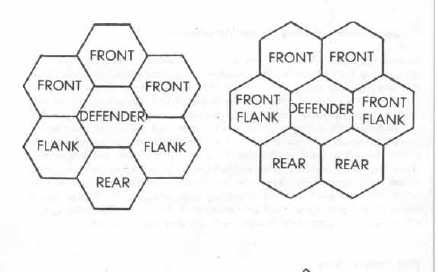


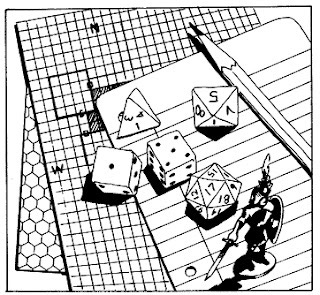

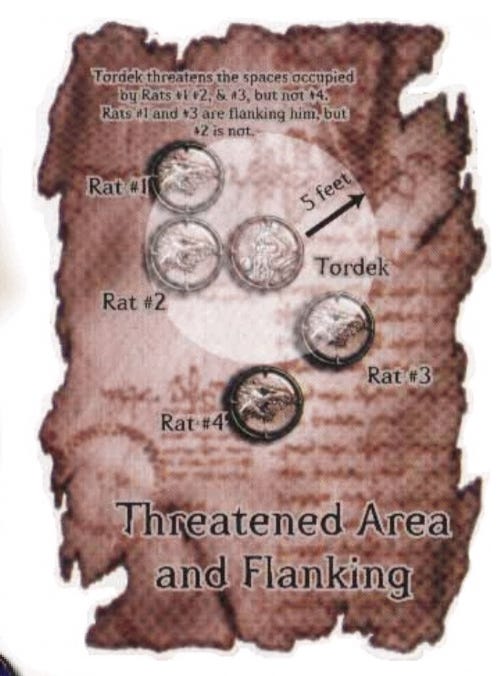
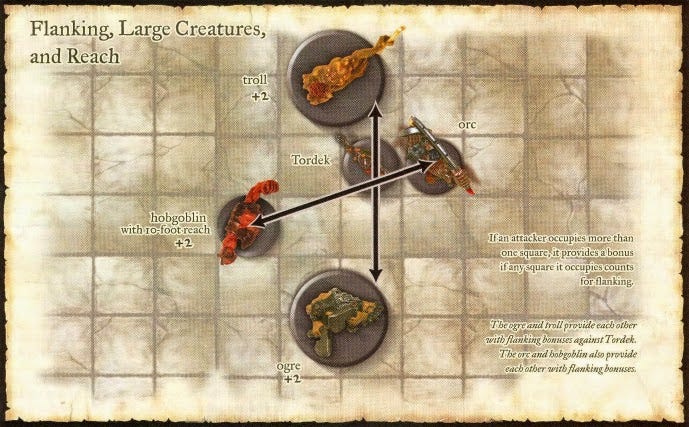
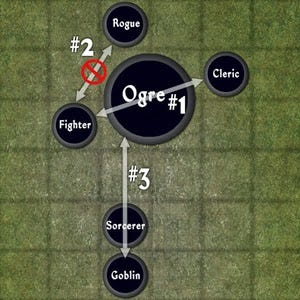
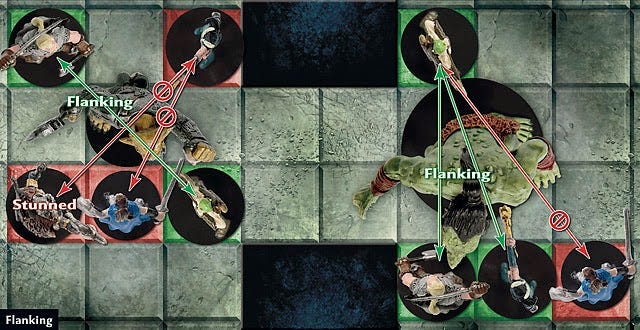
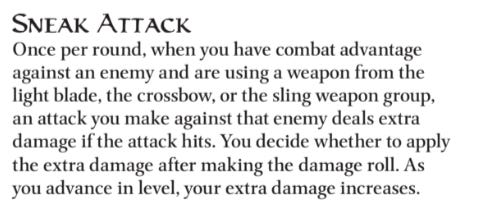

Being introduced to AD&D through the 2nd edition rulebook, I had no idea at the time that people used miniatures at all for AD&D play. I didn't get a 1st edition rulebook until quite recently, and I was astonished to see the use of inch-based measures in stat blocks.
I'd largely overlooked the "zone of control" rules - they're not exactly heavily emphasized in the rulebook - and TBH, I think it makes for a better game in tactical terms if you don't mess around with the action economy using AoO and instead just deal with it in terms of realistic order resolutions (i.e., fleeing doesn't necessarily prevent someone from launching an attack on you that round even if the abstract initiative system says that you "go first," similar to how the system indicates that someone with a longer-reach weapon will strike first during a closing phase).
It's amazing that in high school we played AD&D regularly and I never, ever understood why movement was given in inches. But somehow we managed to play anyway.